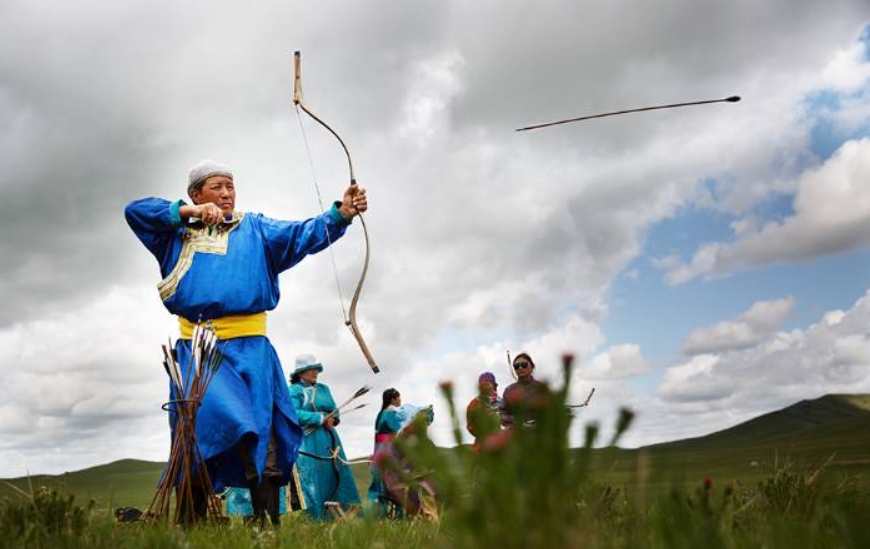Release time:2025-06-30 15:55:39Clicks:author:SPG ArcheryMain categories:Bows, Arrows, Archery Accessories

The so-called primitive society refers to the first community established after humans differentiated from apes. It is the first stage of human history. China's primitive society began with Yuanmou Man about 1.7 million years ago and ended with the establishment of the Xia Dynasty in the 21st century BC. Primitive society went through two periods: primitive people and clan communes. Clan communes went through two stages: matriarchal clan communes and patriarchal clan communes. From the late Paleolithic Age to the Mesolithic Age, the characteristics of human life were cave dwelling or nest dwelling, and the production method was gathering and hunting. The earliest human archery activities may have been gradually bred in such a background.
1. Production and life skills
Labor created humans, and "labor began with the creation of tools" (Engels: "The Role of Labor in the Transformation from Ape to Man", People's Publishing House, 1971, p. 6). It was in the labor process of creating tools that humans continuously improved their own physiological functions and finally completed the great historical transition from ape to man. About 40,000 years ago, modern human beings were formed (Cai Junsheng: "The Formation of Human Society and the Form of Primitive Society", China Social Sciences Press, 1988, p. 14). Therefore, Engels pointed out in "The Role of Labor in the Transformation from Ape to Man": "Only because of labor, because of adapting to the ever-changing movements... can the human hand reach such a high degree of perfection, on this basis it can produce Raphael's paintings, Thorvaldsen's sculptures and Bergannini's music as if by its own ability." The use of tools not only enables "human beings to begin to abandon the simple natural existence, transcend the narrow relationship between animals and nature, and thus consciously distinguish themselves from nature" (Cui Lequan: "A General History of Chinese Sports" Volume 1, People's Sports Press, 2008, p. 11), and can apply running, jumping and throwing, which show the basic activity ability of the human body, to production and life, but also can continuously create and improve production tools to serve their own labor activities and improve production and life efficiency. The emergence of bows and arrows is a historical coordinate with revolutionary significance for primitive humans. As Engels said, "bows, strings, and arrows are already very complex tools. The invention of these tools requires long-term accumulated experience and relatively developed intelligence." Therefore, "bows and arrows are decisive weapons for the elephant taste era, just as iron swords are for the barbaric era and firearms are for the civilized era" (Selected Works of Marx and Engels, Volume 4, People's Publishing House, 1995, page 20).
Chinese bows and arrows were probably born more than 28,000 years ago. A stone was found in the Fengyu site in Shuo County, Shanxi Province. The tip of the stone arrowhead is round and sharp, and there is a tang that has taken shape, which can be used to tie wooden poles. The birth of bows and arrows shows that primitive humans already know how to use the elasticity of objects, and at the same time pay attention to combining the strength of the human body to cleverly obtain more prey to meet human survival and life needs. Of course, from the relevant ethnological data, the arrowheads first made by humans should be mostly made of wood, bamboo and other materials, and using flint should be a later thing, so the history of bows and arrows in China may be even earlier.
Stone arrowheads from the Neolithic Age (collected by the Inner Mongolia Autonomous Region Museum)
In my country, there was a legend that the Dongyi people were the first to invent bows and arrows. For example, "Shuowen Jiezi" says: "Yi means people from the East. From the character "大", from the character "弓". It means what a bow is held." "Shuowen Tongxun Dingsheng" says: "The Dongyi people like to fight and hunt, so the character from the character "大" means holding a bow, which means holding a bow." It is even believed that the inventor was the Dongyi "Pan". For example, "Shan Hai Jing·Hainei Jing" says: "Shao Jin gave birth to Pan, and Pan was the first to make bows and arrows." There are also claims that it was the Dongyi "Zhang Hui". For example, "Shi Ben" records: "Hui made bows, and Na Yi made arrows." Ouyang Xiu once verified in "New Book of Tang·Prime Minister Genealogy" that: "Zhang family originated from the Ji surname. Hui, the fifth son of Shaohao Qingyang, the son of Huangdi, was the bow master and began to make bows and arrows. His descendants were given the surname Zhang." And interestingly, the ancient character for "Zhang" does indeed represent a person holding a bow and about to shoot.
However, it is worth noting that the Yellow Emperor's era was already at the end of the Neolithic Age, which obviously does not match the era of archaeological discoveries. Therefore, the above legends may be understood as the people in the Dongyi area at that time may be slightly better than those in the Central Plains in making and using bows and arrows.